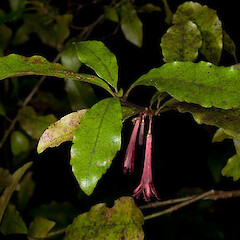Alseuosmia macrophylla
Common name
toropapa, karapapa
Family
Alseuosmiaceae
Flora category
Vascular – Native
Endemic taxon
Yes
Endemic genus
Yes
Endemic family
No
Structural class
Trees & Shrubs - Dicotyledons
NVS code
The National Vegetation Survey (NVS) Databank is a physical archive and electronic databank containing records of over 94,000 vegetation survey plots - including data from over 19,000 permanent plots. NVS maintains a standard set of species code abbreviations that correspond to standard scientific plant names from the Ngä Tipu o Aotearoa - New Zealand Plants database.
ALSMAC
Chromosome number
2n = 18
Current conservation status
The conservation status of all known New Zealand vascular plant taxa at the rank of species and below were reassessed in 2017 using the New Zealand Threat Classification System (NZTCS) – more information about this can be found on the NZTCS website. This report includes a statistical summary and brief notes on changes since 2012 and replaces all previous NZTCS lists for vascular plants.
Please note, threat classifications are often suggested by authors when publications fall between NZTCS assessment periods – an interim threat classification status has not been assessed by the NZTCS panel.
- Conservation status of New Zealand indigenous vascular plants, 2017 . 2018. Peter J. de Lange, Jeremy R. Rolfe, John W. Barkla, Shannel P. Courtney, Paul D. Champion, Leon R. Perrie, Sarah M. Beadel, Kerry A. Ford, Ilse Breitwieser, Ines Schönberger, Rowan Hindmarsh-Walls, Peter B. Heenan and Kate Ladley. Department of Conservation. Source: NZTCS and licensed by DOC for reuse under the Creative Commons Attribution 4.0 International licence.
2017 | Not Threatened
Previous conservation statuses
2012 | Not Threatened
2009 | Not Threatened
2004 | Not Threatened
Brief description
Glossy shrub with strong-smelling, obvious, red, tubular drooping flowers. Leaves glossy, wavy.
Distribution
Endemic. North Island throughout but absent from the central volcanic plateau where it is replaced by A. turneri. South Island, North-West Nelson only
Flower colours
Red/Pink
Life cycle
Fleshy berries dispersed by fruigivory (Thorsen et al., 2009).
Propagation technique
Can be grown from semi-hardwood cuttings though these strike with varying degrees of success. Seed is often hard to germinate. Layers readily. Prefers a semi-shaded site in a cool place with permanently damp soil. Slow growing and prone to sudden collapse during dry spells.
Threats
Although not considered nationally threatened this species is often heavily browsed by ungulates and possums, and rarely sets much viable seed, except where indigenous nectar feeding birds are common - such as on rodent-free offshore islands
Etymology
alseuosmia: Perfume grove
macrophylla: Big leaf
References and further reading
Thorsen, M. J.; Dickinson, K. J. M.; Seddon, P. J. 2009. Seed dispersal systems in the New Zealand flora. Perspectives in Plant Ecology, Evolution and Systematics 2009 Vol. 11 No. 4 pp. 285-309
NZPCN Fact Sheet citation
Please cite as: de Lange, P.J. (Year at time of access): Alseuosmia macrophylla Fact Sheet (content continuously updated). New Zealand Plant Conservation Network. https://www.nzpcn.org.nz/flora/species/alseuosmia-macrophylla/ (Date website was queried)












